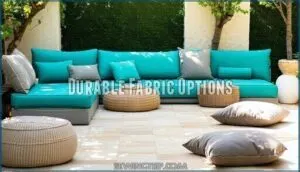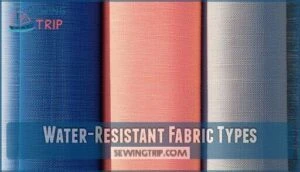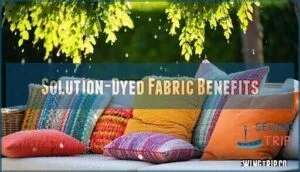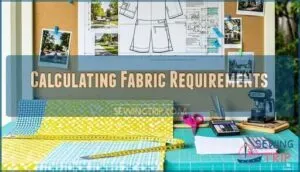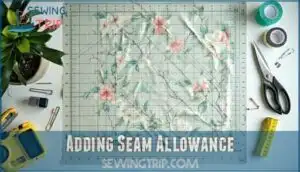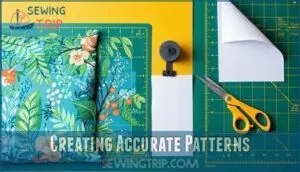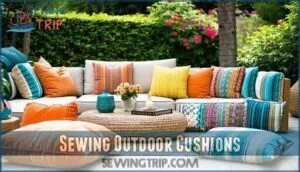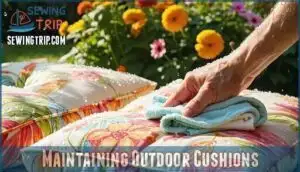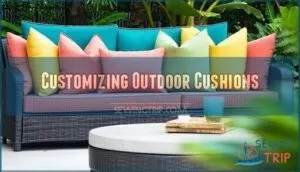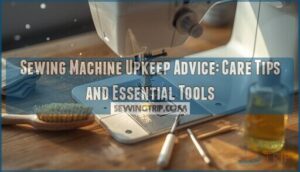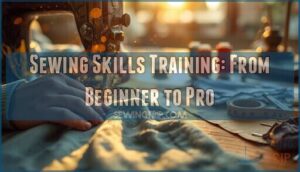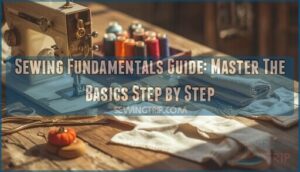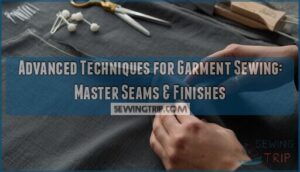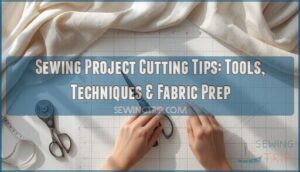This site is supported by our readers. We may earn a commission, at no cost to you, if you purchase through links.
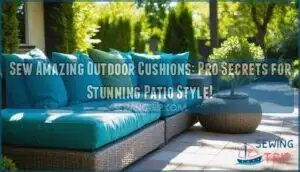
These materials resist fading because the color penetrates every fiber, not just the surface. They’re also water-resistant and mildew-proof, making them perfect for patio life.
Outdoor canvas and marine-grade vinyl work well too, though they need more maintenance. Skip regular cotton or polyester – they’ll fade faster than your summer tan and fall apart after one season.
Look for fabrics labeled "outdoor" or "marine grade" at fabric stores. The right fabric choice means your handmade cushions will survive countless barbecues and thunderstorms while staying vibrant.
Table Of Contents
Key Takeaways
- You’ll want solution-dyed acrylic fabrics like Sunbrella for outdoor cushions because they resist fading, repel water, and fight mildew better than regular cotton or polyester that’ll deteriorate after one season.
- You need to add one inch to both width and depth measurements for seam allowance, use heavy-duty polyester thread, and install waterproof zippers to create professional-looking cushions that won’t fall apart.
- You should clean your cushions monthly with mild soap, apply waterproofing spray annually, and store them in dry indoor spaces during winter to extend their lifespan to 5-10 years.
- You can customize your cushions with contrasting welting, bold color combinations, and unique shapes to transform basic patio furniture into designer-worthy statement pieces at a fraction of retail cost.
Choosing Outdoor Fabric
Picking the right outdoor fabric is all about balancing durability, water resistance, and style.
Think of it like choosing a raincoat—strong enough for rough weather but still looking good in the sunshine!
Like armor for your patio—tough enough for storms, stylish enough for sunset cocktails!
Durable Fabric Options
When picking a durable outdoor fabric, think longevity and toughness.
Sunbrella’s weather resistance and fade protection last years. Olefin handles stains like a pro, while polypropylene fabric shrugs off moisture and keeps colors fresh.
Want UV-resistant fabric? Solution-dyed acrylic’s your go-to. Compare materials for cleaning ease and fabric lifespan.
Sunbrella’s fade resistance guarantees lasting color vibrancy. It’s about style, but also survival!
Water-Resistant Fabric Types
When selecting outdoor fabric for your patio cushions, you’ll find several water-resistant options.
Olefin fabrics dry quickly and resist moisture naturally. Polyester with fabric coatings offers good protection at budget-friendly prices.
Acrylic blends like Sunbrella provide excellent water resistance through tight weave density.
These synthetic blends outperform natural options while maintaining decent breathability levels for comfort. For example, solution-dyed polyesters offer enhanced UV resistance.
UV-Resistant Fabric Choices
You’ll want UV resistant fabric that laughs in the face of blazing sun.
Sunbrella fabric leads the pack with superior fade resistant fabric technology, boasting 1000+ light hours of testing standards.
Compare material comparison specs – acrylic beats polyester for color retention and fabric lifespan.
Check weave density too; tighter weaves block more rays, keeping your outdoor cushions looking fresh longer.
Solution-Dyed Fabric Benefits
Solution-dyed acrylic fabric offers unmatched colorfastness explained through its unique manufacturing process.
Unlike surface-dyed materials, colors penetrate every fiber during production, creating superior fade resistant fabric that laughs at harsh sunlight. Your outdoor fabric investment pays dividends year after year.
Synthetic options offer reliable performance in outdoor conditions.
- UV Protection: Solution dyed acrylic provides exceptional UV resistant fabric performance, blocking harmful rays that destroy regular textiles
- Stain Resistance: Spills wipe away easily from this outdoor fabric durability champion, keeping cushions looking fresh
- Long-Term Value: Superior fade resistance means your outdoor fabric stays vibrant for 5-10 years with proper care
Measuring Cushion Size
You’ll need to measure your furniture’s seat width and depth first, then add one inch to each dimension for seam allowance—think of it like giving your cushion a little breathing room.
Getting these measurements right from the start saves you from that awkward moment when your beautiful new cushion cover fits like a too-small sweater on your favorite chair.
Calculating Fabric Requirements
Once you’ve chosen your outdoor fabric, it’s time to crunch the numbers. Calculating yardage estimation prevents costly mistakes and waste reduction. Start by measuring your cushion dimensions twice – nobody wants to run short mid-project!
Consider fabric width and pattern repeats when planning cuts. For heavy-use pieces, remember to think about durable fabric textures for longevity. Smart calculations mean cost optimization and enough cushion fabric for beautiful outdoor cushions.
| Cushion Size | Fabric Needed | Extra for Matching |
|---|---|---|
| 18" x 18" | 1.5 yards | 0.25 yards |
| 20" x 20" | 1.75 yards | 0.5 yards |
| 24" x 24" | 2.25 yards | 0.75 yards |
Proper fabric cutting starts with accurate measurements and planning. This ensures that you have the right amount of fabric for your project, reducing waste and saving you money in the long run, which is a key part of longevity and overall project success.
Adding Seam Allowance
Accurate measurement means nothing without proper seam allowance planning. You’ll need that extra fabric to create strong, professional-looking cushion covers that won’t fall apart after one summer storm.
Here’s your seam allowance game plan:
- Add 1 inch to both width and depth measurements for standard ½-inch seams
- Include extra fabric for zipper installation and corner reinforcement
- Account for fabric shrinkage by adding an additional ¼ inch buffer
- Mark seam allowance lines clearly to prevent cutting precision errors
- Calculate total fabric waste to avoid running short mid-project
Creating Accurate Patterns
Paper patterning saves you from costly fabric mistakes.
Create cardboard templates using your measurements plus seam allowance, then trace onto fabric for perfect pattern pieces.
A rotary blade gives clean cuts while fabric smoothing prevents wrinkles that throw off accuracy.
Test your patterns on scrap fabric first—this step guarantees sewing precision and proper foam shaping before cutting your good material, ensuring perfect pattern pieces and ultimately leading to successful fabric use.
Sewing Outdoor Cushions
You’ve measured your cushions perfectly, and now it’s time to turn those fabric pieces into weather-ready masterpieces that’ll make your neighbors wonder if you hired a professional.
With the right thread, zippers, and sewing techniques, you’ll create cushions that can handle whatever Mother Nature throws at them while looking like they belong in a fancy outdoor magazine.
Using High-Quality Thread
Once you’ve got your measurements down pat, let’s talk thread – the unsung hero of outdoor cushion projects.
High-quality polyester thread delivers superior UV resistance and seam strength that’ll outlast cheaper alternatives by years. Don’t skimp here!
For enhanced durability, consider using specialized UV thread.
Match your thread color to your fabric for seamless results. Quality thread means your sewing supplies investment pays off with cushions that won’t fall apart.
Selecting Best Zippers
When selecting zippers for outdoor cushions, you’ll want waterproof options that can handle Mother Nature’s tantrums.
Choose molded tooth zippers with polyurethane coatings for maximum durability and weather resistance.
- Zipper Material: Pick polyurethane-coated or rubber-sealed zippers that repel moisture
- Zipper Size: Select heavy-duty #8 or #10 zippers for strength
- Zipper Type: Choose separating zippers for easy cushion removal
- Zipper Placement: Position along back edge for hidden, professional appearance
For best results, consider how zipper feet techniques can improve the installation process.
Sewing Machine Techniques
Properly adjusting your sewing machine transforms outdoor cushion construction from frustrating to fabulous.
Set stitch length to 2.5-3mm for sturdy seams through thick fabric.
Select heavy-duty needles (size 16-18) to pierce outdoor materials cleanly.
Adjust tension settings slightly tighter than normal cotton settings.
Install your zipper foot for professional zipper installation.
These sewing techniques guarantee smooth stitching every time, making the process frustrating to enjoyable.
Reinforcing Seams
Strong reinforced seams keep your cushions together through storms and sun.
Use backstitching tips at stress points like corners where fabric pulls apart.
A durable stitch with shorter stitch length creates tighter bonds.
Try zigzag stitching over straight seams for extra strength.
Add reinforcement fabric behind high-wear areas.
Consistent stitching prevents embarrassing blowouts during dinner parties.
Maintaining Outdoor Cushions
You’ve spent time crafting the perfect outdoor cushions, but now you need to keep them looking fresh and lasting through countless seasons of use.
Transform ordinary patio furniture into designer-worthy outdoor oases with cushions that laugh at weather while looking effortlessly chic.
Smart maintenance habits will protect your investment and guarantee your cushions stay comfortable, colorful, and ready for every backyard gathering.
Think of it as giving your outdoor furniture a little spa treatment that pays off big time.
Regular Cleaning Methods
Keeping your outdoor cushions looking fresh doesn’t require rocket science.
Start with mild soap solutions for general cleaning, tackling spot cleaning spills immediately before they set.
Your washing machine care routine should include removable covers monthly, and follow a basic stain removal guide: blot, don’t rub.
Preventative measures like regular vacuuming beat deep cleaning marathons every time.
Waterproofing Techniques
Regularly applying waterproofing spray creates your first line of defense against moisture damage.
Fabric sprays like Scotchgard work wonders when applied to clean, dry surfaces.
For serious protection, consider seam sealing critical areas and adding waterproof liner options underneath. These DIY methods beat expensive replacements every time—your wallet will thank you later!
Storing Cushions Properly
Three simple steps transform your cushions from weathered to wonderful when winter arrives.
First, give them a thorough cleaning before tucking them away—nobody wants musty surprises come spring!
Your best storage options include:
- Airtight containers in basements or garages for ultimate protection
- Cool, dry indoor spaces away from moisture and critters
- Protective covers if outdoor storage is your only option
This approach ensures your cushions remain in good condition, ready for use when the weather improves, and provides a thorough method for maintaining them.
Extending Cushion Lifespan
Beyond proper storage comes the real secret to outdoor cushion longevity.
Your cushion fabric can last 5-10 years with smart habits. Limit sun exposure during peak hours, tackle stain removal immediately, and prevent mildew with regular cleaning.
Apply fabric protection treatments annually. Think of it as sunscreen for your outdoor cushions—winter storage and consistent outdoor fabric care pay off big time.
Customizing Outdoor Cushions
You can transform basic outdoor cushions into stunning statement pieces by adding contrasting welting, creating unique color combinations, and incorporating personal design touches that match your patio’s style perfectly.
Think of customization as your chance to make furniture that looks like it came straight from an expensive outdoor showroom, but at a fraction of the cost and with exactly the colors you love.
Adding Welting Details
When you’re ready to elevate your cushions from basic to brilliant, welting creates that professional finish that screams "I know what I’m doing!"
Cut your outdoor fabric on the bias for flexibility, then wrap it around welting cord like you’re gift-wrapping a pencil.
Attach this piping between your cushion fabric layers before sewing welting seams for crisp, durable edges.
Consider also the fabric’s rub count to guarantee longevity.
Using Contrasting Fabric
Bold color combinations transform plain outdoor cushions into eye-catching statement pieces.
Mix patterns like stripes with florals, or pair solid outdoor fabric with textured weaves for stunning fabric blocking effects.
Try accent piping in contrasting hues—navy welting on cream cushion fabric creates crisp definition.
Texture contrast adds depth when you combine smooth Sunbrella with nubby canvas for patio cushions, creating a visually appealing effect with bold color combinations.
Creating Custom Designs
Pattern Personalization lets you break free from boring squares.
Try Unique Shapes like hexagons or circles for your custom cushions. Mix bold Fabric Combinations – stripes with florals create eye-catching outdoor cushions.
Add Embellishment Options like appliqué or decorative stitching. Design Software helps visualize your fabric for patio cushions before sewing.
Your DIY creativity makes ordinary furniture extraordinary!
Enhancing Comfort and Style
With thoughtful Pattern Selection and Color Coordination, you’ll transform basic outdoor cushions into stylish statement pieces.
Choose Fabric Texture that complements your space’s Design Aesthetics while prioritizing Ergonomic Cushioning for maximum outdoor comfort.
Mix bold patterns with solid colors, or create visual interest through contrasting piping. Your outdoor cushion sewing project becomes a personal canvas for expressing creativity.
Frequently Asked Questions (FAQs)
What type of fabric is best for outdoor cushions?
Sure, you could use regular cotton and watch it turn into a moldy mess!
Instead, choose solution-dyed acrylic fabrics like Sunbrella.
They’re fade-resistant, waterproof, and won’t betray you during summer storms.
What is the best thread to sew outdoor cushions?
You’ll want heavy-duty polyester or upholstery thread for outdoor cushions.
Choose UV-resistant thread that won’t break down in sunlight.
Gutermann or Coats brands work great—they’re strong enough to handle weather and washing cycles.
What fabric is like Sunbrella but cheaper?
Looking for budget-friendly alternatives to pricey Sunbrella?
You’ll love Outdura, SunRite, and Richloom fabrics—they offer similar weather resistance and durability at friendlier prices.
Canvas duck cloth also works great for tight budgets.
What kind of stuffing do you use for outdoor cushions?
You’ll want waterproof, quick-drying foam or poly-fil stuffing for outdoor cushions.
CushionRite Dry Fast foam wrapped in polyester batting works great, giving you comfort while handling rain and humidity like a champ.
How do you repair torn outdoor cushion fabric?
Like a battlefield medic mending armor, you’ll need outdoor fabric patches, fabric glue, or heavy-duty thread.
Clean the tear, apply patch from underneath, then stitch or glue edges securely for weather-resistant repairs.
Can you dye existing outdoor cushion covers?
You can dye existing outdoor cushion covers, but results vary by fabric type.
Synthetic materials like polyester and acrylic resist dye uptake.
Natural fibers work better, though outdoor treatments may interfere with color absorption, making natural fibers less predictable.
What foam density works best for outdoor cushions?
You’ll want medium-density foam (around 2-3 pounds per cubic foot) for outdoor cushions. It provides excellent support without being too firm, resists compression, and bounces back beautifully after use.
How do you prevent mold growth in cushions?
An ounce of prevention beats a pound of cure when fighting mold.
Choose quick-drying foam, make certain proper ventilation with grommets, store cushions indoors during wet seasons, and clean spills immediately to keep mold at bay, as this is a key part of prevention.
Should you prewash outdoor fabric before sewing?
You should prewash outdoor fabric only if you plan to machine-wash the finished cushion covers later.
Most performance fabrics like Sunbrella don’t require prewashing since they’re pre-treated and won’t shrink substantially.
Conclusion
Creating beautiful outdoor cushions isn’t rocket science, even if you’re new to sewing.
With the right fabric for outdoor cushions sewing projects, proper techniques, and quality materials, you’ll craft stunning pieces that outlast store-bought alternatives.
Your patio will become the neighborhood gathering spot with custom cushions that resist weather, maintain their vibrant colors, and provide lasting comfort.
Start your first project today – your outdoor space deserves handmade style that reflects your personality perfectly, and with these tips, you’ll achieve a space that is truly unique.
- https://www.sunbrella.com/browse-fabrics/fabrics-by-use/outdoor-fabric
- https://revolutionfabrics.com/pages/how-to-choose-the-best-outdoor-fabric-for-cushions
- https://www.fabricguru.com/all-outdoor-fabric
- https://authenteak.com/blog/how-to-choose-the-best-outdoor-fabric-for-your-furniture
- https://www.patioproductions.com/blog/quick-answers/the-secret-to-the-comfiest-outdoor-cushions

